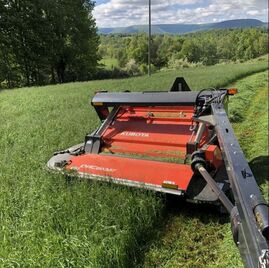CONSERVATION CORNER
A weekly blog for all things conservation
 By BRIAN ZEIDNER Over the summer I shared some of my hay-making experiences with you. I wrote about using nitrogen fertilizer, commonly known as urea, on hay fields. Many hay producers really want to know — Is it worth it? To answer that question, we must measure the quantity and quality of the harvest. As noted previously, my first cutting off-farm, non-fertilized fields produced less than two round bales per acre, while my on-farm nitrogen-fertilized ground produced 5.5 round bales per acre. The increase in the amount of hay certainly seems substantial. I also measured the quality of the hay using forage tests. I am raising beef cows and although there are many forage considerations, I look closely at three different measures on my forage tests, Crude Protein (CP), Neutral Detergent Fiber (NDF) and Energy (TDN). Although I reference these factors there are many other measurements on forage tests that a professional nutritionist may use to make recommendations. Generally speaking, the higher the Crude Protein and Energy and the lower the NDF, the better. My highest CP this year at 17.1%, was first cutting on-farm baleage made on May 21st. The NDF was 50.7% and the TDN was 66.1%. On this feed, my cows, calves, and steers can continue to grow well and hold body condition even with no supplemental feed, and even during extremely cold weather. Now let’s compare apples to apples. On June 6th I made a lot of dry hay, both on-farm and off-farm. I have worked for many years building soil on the farm by spreading lime, manure and fertilizer based on soil samples I took and analyzed, usually with help from the ag team at the Bradford County Conservation District. I also applied urea to the on-farm acreage this spring at about 200 lbs./acre. Although the NDF and the TDN levels were similar, my dry hay tested at 11.8% CP, compared to 8.65% CP of the off-farm hay. As you have probably guessed, many factors contribute to good quality forage, including soil quality, nitrogen and fertilizer application and harvesting the crop at its peak. Also, there is definitely correlation between soil quality and forage quality, and this is apparent across several measurements on the analysis reports. So, is it worth it? My theory is, yes, the cost and the effort of making quality hay is worth it. As described above, this year I have experienced a three-fold increase in quantity of hay and a 30% (and more) increase in quality. I don’t have to purchase additional hay or supplemental grain to feed the herd, and they are in great body condition year-round. Using my experience as an example for 100 first cutting round bales, I would use 3,600 lbs. of urea applied at 200 lbs./acre on 18 acres to get my (first cutting) 5.5 bale yield. This year the cost of urea was $610 per ton, or $1,100 for the 18 acres. If I didn’t buy urea and had a yield of two bales per acre, I would make 36 bales and need to purchase 64 bales. The cost of hay varies, but if I purchased 64 bales at $40 each, I would spend $2,650. I may or may not get the quality I need from purchased hay. If I needed to purchase supplemental corn or protein pellets because of poor quality purchased hay, I will have to spend additional money. I won’t try to estimate what the costs of supplemental feed might be. I love making high-quality hay. Knowing the herd is healthy, happy, and productive because of the forages I produce is deeply satisfying. I hope you enjoy it too. If you want to improve your hay-making operation, give the team at the Bradford County Conservation District a call. They are outstanding, have been a great help to me and are available to you as well. Brian Zeidner and his wife Pat own and operate a 42-acre beef farm in Bradford County. Brian also works as the Member Service Director for Claverack Rural Electric Cooperative, serves as the chairman of the Bradford County Farmland Preservation board, is the co-chair of the Northern Tier Industry and Education Consortium and is a United States Air Force veteran
0 Comments
Leave a Reply. |
AuthorsVarious staff at the Bradford County Conservation District Archives
July 2024
Categories
All
|
|
Bradford County Conservation District
Stoll Natural Resource Center 200 Lake Road, Suite E | Towanda PA 18848 Phone: (570)-485-3144 |
